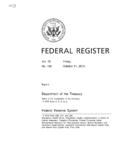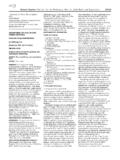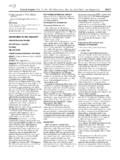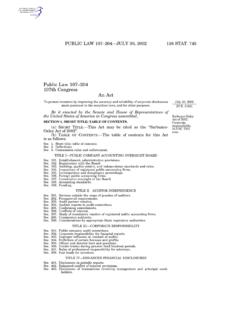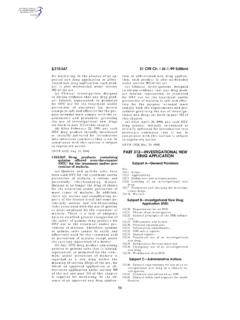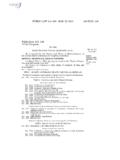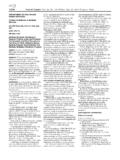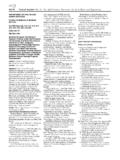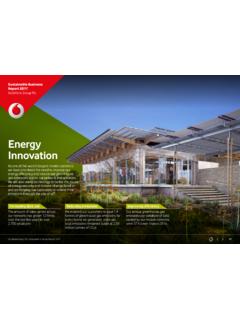Transcription of 15871 Federal Register Presidential Documents
1 Presidential Documents15871 Federal Register Vol. 80, No. 57 Wednesday, March 25, 2015 Title 3 The President executive order 13693 of March 19, 2015 Planning for Federal Sustainability in the Next Decade By the authority vested in me as President by the Constitution and the laws of the United States of America, and in order to maintain Federal leadership in sustainability and greenhouse gas emission reductions, it is hereby ordered as follows: Section 1. Policy. executive departments and agencies (agencies) have been among our Nation s leaders as the United States works to build a clean energy economy that will sustain our prosperity and the health of our people and our environment for generations to come.
2 Federal leadership in energy, environmental water, fleet, buildings, and acquisition management will continue to drive national greenhouse gas reductions and support prep-arations for the impacts of climate change. Through a combination of more efficient Federal operations such as those outlined in this executive order ( order ), we have the opportunity to reduce agency direct greenhouse gas emissions by at least 40 percent over the next decade while at the same time fostering innovation, reducing spending, and strengthening the commu-nities in which our Federal facilities operate. It therefore continues to be the policy of the United States that agencies shall increase efficiency and improve their environmental performance.
3 Im-proved environmental performance will help us protect our planet for future generations and save taxpayer dollars through avoided energy costs and increased efficiency, while also making Federal facilities more resilient. To improve environmental performance and Federal sustainability, priority should first be placed on reducing energy use and cost, then on finding renewable or alternative energy solutions. Pursuing clean sources of energy will improve energy and water security, while ensuring that Federal facilities will continue to meet mission requirements and lead by example. Employing this strategy for the next decade calls for expanded and updated Federal environmental performance goals with a clear overarching objective of reduc-ing greenhouse gas emissions across Federal operations and the Federal supply chain.
4 Sec. 2. Agency Greenhouse Gas Emission Reductions. In implementing the policy set forth in section 1 of this order , the head of each agency shall, within 90 days of the date of this order , propose to the Chair of the Council on Environmental Quality (CEQ) and the Director of the Office of Management and Budget (OMB) percentage reduction targets for agency-wide reductions of scope 1 and 2 and scope 3 greenhouse gas emissions in absolute terms by the end of fiscal year 2025 relative to a fiscal year 2008 baseline. Where appropriate, the target shall exclude direct emissions from excluded vehicles and equipment and from electric power produced and sold commercially to other parties as the primary business of the agency.
5 The proposed targets shall be subject to the review and approval of the Chair of CEQ in coordina-tion with the Director of OMB under section 4(b) of this order . Sec. 3. Sustainability Goals for Agencies. In implementing the policy set forth in section 1 of this order and to achieve the goals of section 2 of this order , the head of each agency shall, where life-cycle cost-effective, beginning in fiscal year 2016, unless otherwise specified: (a) promote building energy conservation, efficiency, and management by: VerDate Sep<11>2014 17:53 Mar 24, 2015 Jkt 235001 PO 00000 Frm 00003 Fmt 4705 Sfmt 4790 E:\FR\FM\ 25 MRE0asabaliauskas on DSK5 VPTVN1 PROD with PRESDOCS15872 Federal Register / Vol.
6 80, No. 57 / Wednesday, March 25, 2015 / Presidential Documents (i) reducing agency building energy intensity measured in British thermal units per gross square foot by percent annually through the end of fiscal year 2025, relative to the baseline of the agency s building energy use in fiscal year 2015 and taking into account agency progress to date, except where revised pursuant to section 9(f) of this order , by implementing efficiency measures based on and using practices such as: (A) using remote building energy performance assessment auditing tech-nology; (B) participating in demand management programs; (C) ensuring that monthly performance data is entered into the Environ-mental Protection Agency (EPA) ENERGY STAR Portfolio Manager for covered buildings; (D) incorporating, where feasible, the consensus-based, industry standard Green Button data access system into reporting, data analytics, and automa-tion processes; (E) implementing space utilization and optimization practices and policies; (F) identifying opportunities to transition test-bed technologies to achieve the goals of this section; and (G) conforming, where feasible, to city energy performance benchmarking and reporting requirements.
7 And (ii) improving data center energy efficiency at agency facilities by: (A) ensuring the agency chief information officer promotes data center energy optimization, efficiency, and performance; (B) installing and monitoring advanced energy meters in all data centers by fiscal year 2018; and (C) establishing a power usage effectiveness target of to for new data centers and less than for existing data centers; (b) ensure that at a minimum, the following percentage of the total amount of building electric energy and thermal energy shall be clean energy, ac-counted for by renewable electric energy and alternative energy: (i) not less than 10 percent in fiscal years 2016 and 2017; (ii) not less than 13 percent in fiscal years 2018 and 2019; (iii) not less than 16 percent in fiscal years 2020 and 2021; (iv) not less than 20 percent in fiscal years 2022 and 2023; and (v) not less than 25 percent by fiscal year 2025 and each year thereafter; (c) ensure that the percentage of the total amount of building electric energy consumed by the agency that is renewable electric energy is: (i) not less than 10 percent in fiscal years 2016 and 2017; (ii) not less than 15 percent in fiscal years 2018 and 2019; (iii) not less than 20 percent in fiscal years 2020 and 2021; (iv) not less than 25 percent in fiscal years 2022 and 2023.
8 And (v) not less than 30 percent by fiscal year 2025 and each year thereafter; (d) include in the renewable electric energy portion of the clean energy target established in subsection (b) of this section renewable electric energy as defined in section 19(v) of this order and associated with the following actions, which are listed in order of priority: (i) installing agency-funded renewable energy on site at Federal facilities and retaining corresponding renewable energy certificates (RECs) or obtain-ing equal value replacement RECs; (ii) contracting for the purchase of energy that includes the installation of renewable energy on site at a Federal facility or off site from a Federal facility and the retention of corresponding RECs or obtaining equal value replacement RECs for the term of the contract; VerDate Sep<11>2014 17:53 Mar 24, 2015 Jkt 235001 PO 00000 Frm 00004 Fmt 4705 Sfmt 4790 E:\FR\FM\ 25 MRE0asabaliauskas on DSK5 VPTVN1 PROD with PRESDOCS15873 Federal Register / Vol.
9 80, No. 57 / Wednesday, March 25, 2015 / Presidential Documents (iii) purchasing electricity and corresponding RECs or obtaining equal value replacement RECs; and (iv) purchasing RECs; (e) include in the alternative energy portion of the clean energy target established in subsection (b) of this section alternative energy as defined in section 19(c) of this order and associated with the following actions, where feasible: (i) installing thermal renewable energy on site at Federal facilities and retaining corresponding renewable attributes or obtaining equal value re-placement RECs where applicable; (ii) installing combined heat and power processes on site at Federal facili-ties; (iii) installing fuel cell energy systems on site at Federal facilities; (iv) utilizing energy from new small modular nuclear reactor technologies; (v) utilizing energy from a new project that includes the active capture and storage of carbon dioxide emissions associated with energy generation.
10 (vi) implementing other alternative energy approaches that advance the policy set forth in section 1 and achieve the goals of section 2 of this order and are in accord with any sustainability, environmental perform-ance, and other instructions or guidance established pursuant to sections 4(e) and 5(a) of this order ; and (vii) including in the Department of Defense (DOD) accounting for alter-native energy for this subsection, fulfillment of the requirements for DOD goals established under section 2852 of the National Defense Authorization Act for Fiscal Year 2007 as amended by section 2842 of the National Defense Authorization Act for Fiscal Year 2010; (f) improve agency water use efficiency and management, including stormwater management by: (i) reducing agency potable water consumption intensity measured in gal-lons per gross square foot by 36 percent by fiscal year 2025 through reductions of 2 percent annually through fiscal year 2025 relative to a baseline of the agency s water consumption in fiscal year 2007; (ii) installing water meters and collecting and utilizing building and facility water balance data to improve water conservation and management.

